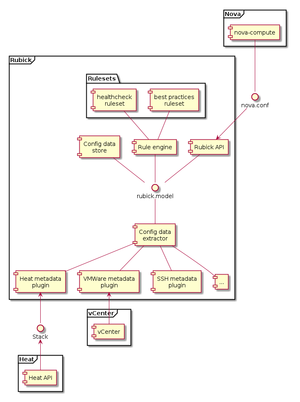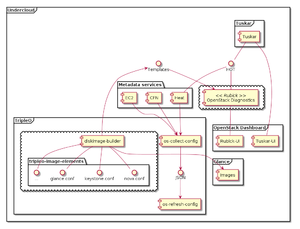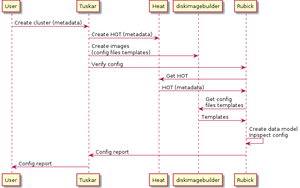Rubick/OpenStack Integration
Contents
Use Case #1. Validate configration consistency of individual service
This use case is inspired by blueprint drafted by Nova VMWare driver team: https://blueprints.launchpad.net/nova/+spec/config-validation-script
Create a configuration check framework which will check the core service endpoints as well as the hypervisor configuration. This script can be used before starting openstack to verify that the configuration is correct. Initially this will be a nova config check but could be used for other services as well. Specific to the VC driver - It would also be nice if (perhaps a different scipt) could connect to a given VC and extract the proper configuration for that VC - i.e. the cluster, datastore regex etc
This use case will require implementation of additional collector plugins:
- vCenter collector capable of collecting vCenter server configuration.
- service collector is a library which might be called at the time of service initialization and talk to Rubick to validate configuration params of the service against the set of services Rubick already aware of.
Use Case #1 requirements summary
Look for summary of requirements and initial implementation plan in Etherpad: https://etherpad.openstack.org/p/w5BwMtCG6z
Use Case #2. Validate initial configuration
OpenStack Diagnostics could add value to OpenStack Deployment by providing on-demand or automated verification of OpenStack configuration created by user of Deployment tools.
OpenStack Deployment (TripleO) allows user to manage OpenStack cloud (called 'overcloud' in terms of TripleO) as standard OpenStack environment. This involves Heat, Nova with baremetal driver (or Ironic service) and Tuskar as a user interface application, all installed in small 'management' environment called 'undercloud'.
When user wants to install 'overcloud', he uses Tuskar UI to configure bare metal in cluster and set roles for all nodes. Tuskar then creates Heat Orcestration Template (HOT) which describes overcloud architecture. This template also contains node-specific configurations of overcloud OpenStack components as nodes metadata. This template could be used by Diagnostics as a source of information for analysis.
Currently (as of Havana release) there is no support for automated creation of images for overcloud nodes in TripleO. However, once such functionality added to the project, Diagnostics could fetch base configuration templates for all overcloud components. Until then, user will have to provide these templates to Diagnostics service via API.
Combining node-specific metadata with configuration templates, Diagnostics will have comprehensive configuration information for the new 'overcloud' and will be able to match it to ruleset to verify configuration consistency.
The following diagram illustrates architecture of the described case:
The following sequence diagram shows data exchange in dynamic:
This diagram shows integration points between OpenStack TripleO (OpenStack on OpenStack) program and the diagnostics system. Diagnostic system will perform the following steps:
- extract initial environment configuration from metadata services of the 'undercloud'. Heat Orchestration Templates for OpenStack 'overcloud' describe nodes and their roles, as well as configuration parameters.
- populate an architecture data model with actual configuration parameters from metadata services.
- run inspections through the architecture data model by set of production rules defined by user, or selected by user from the list of all available rules, defined externally.
- report results of inspection as a list of rules that were checked with indication of matched and unmatched rules. For unmatched rules, diagnostics could give recommendations and hints.
Use Case #3: Diagnostic API
Introduced by OpenStack infra team as a part of initiative to improve debuggability go the OpenStack CI gating process, this case involves creating API which could be used to get 'state of world' for OpenStack services. This state inlcudes hardware- and system-level configuration parameters of the platform and has huge overlap with Rubick's vision of architecture/configration data model. It will be implemented by exposing the data model via REST API. Configuration collection must be made possible upon request, using collection agents.



